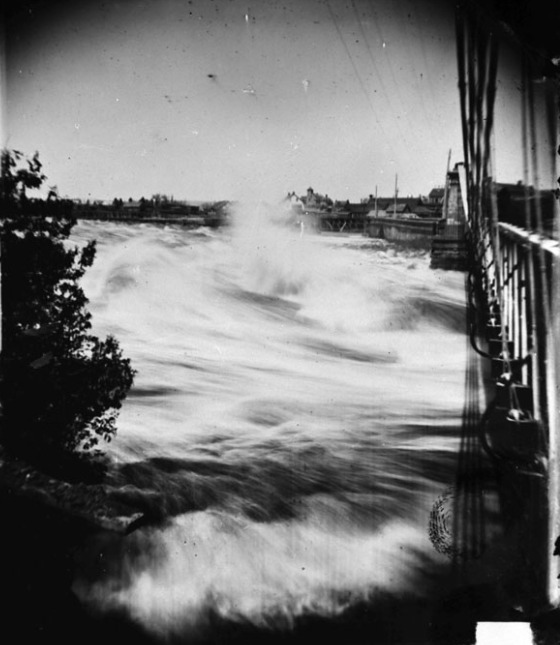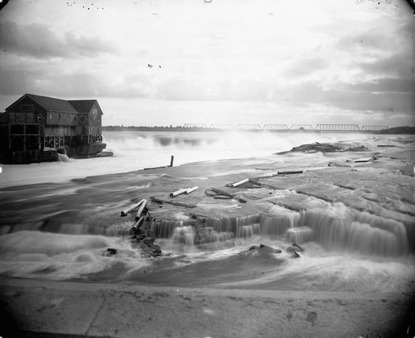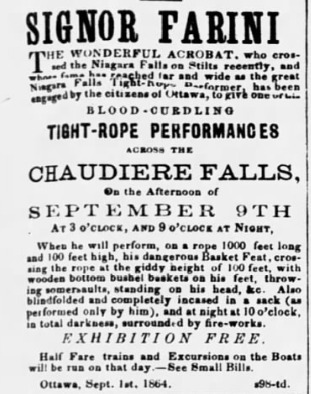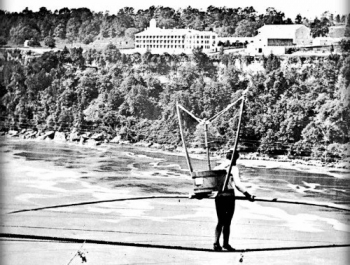9 September 1864
Back in the mid-nineteenth century, the world was wowed by Jean François Gravelet, better known as the Great Blondin. In June 1859, in front of a crowd of 25,000 fascinated and horrified onlookers, Blondin crossed the Niagara Gorge from the United States to Canada on a tightrope. On his return trip, he brought a daguerreotype camera with him to take a photo of the spectators.
One of Blondin’s greatest fans was a young man from Port Hope, Ontario named William Leonard Hunt. Hunt was born in June 1838 in Lockport, New York but grew up close to Port Hope where his parents settled after living for a time in the United States. As a child, he was a daredevil and was fascinated with all things related to the circus—much to his parents’ chagrin who view such activities as dishonourable. Hunt gave his first professional performance as a funambulist (tightrope walker) at age twenty-one by crossing the Ganaraska River in Port Hope on a rope stretched eighty feet high between two buildings, just months after Blondin’s conquest of Niagara Falls. Hunt chose the stage name Signor Guillermo (Italian for William) Farini, or the “Great Farini.”
The Great Farini challenged Blondin to a battle of who would be considered the greatest tightrope walker in the world. Signor Farini matched his idol’s feat by crossing the Niagara Gorge in June 1860. He topped off his performance by hanging from the rope mid-river by one hand, then suspending himself by just his feet. On a subsequent trip, after securing his pole, he climbed down a rope to the tourist boat Maid of the Mist circling below in the Niagara River, drank a glass of wine, and then climbed back up to finish his journey across the Gorge.
The rivalry of the two men took off. Blondin walked across the Falls with his feet in bushel baskets, pushed his manager in a wheel barrow, and even cooked omelettes on a portable stove high above the whirlpools, which he lowered to sightseers on the Maid of the Mist below. Farini responded by carrying his much larger manager across the Falls. Mid-river, Farini somehow unloaded his manager onto the rope, crawled on the underside of the rope beneath his friend to emerge on the other side, and then reloaded him onto his back before finishing the crossing. (Where do you find friends like this?!) Subsequently, Farini washed hankies mid-river using an Empire Washing Machine that he had brought with him across the high wire.
Needless to say, Farini was a sensation. It helped that he was darkly handsome, muscular, with brilliant blue eyes and slicked back black hair. He also worn a goatee with a waxed moustache that extended horizontally several inches on either side of his nose in a style popularized by France’s Napoleon III. He was also extremely articulate and spoke several languages.
After a brief stint in the Union Army in the United States during the American Civil War where he rose to the rank of Captain in the Engineers, he returned to the circus. While performing with his first wife, Mary, in a high wire act above the Plaza de Toros in Havana, Cuba in December 1862, tragedy struck. On their fifth crossing with his wife on his back, Mary unexpectedly waved to cheering spectators. Losing her balance, she fell. Somehow, Farini managed to grab her costume as she tumbled past him, but it was not enough. The fabric ripped and she fell sixty feet in front of a horrified crowd of 15,000 people. She died a few days later.
This catastrophe did not stop his high-wire career. In 1864, he came to Ottawa, which was then in the news owing to negotiations underway in Charlottetown, Prince Edward Island among the British colonies in North America on Confederation. If those negotiations were successful, Ottawa would become the capital of a large new nation.
 The Chaudière Falls with the Union Suspension Bridge on the right.
The Chaudière Falls with the Union Suspension Bridge on the right.
Circa 1869, Topley Studio, Library and Archives Canada, PA-102695According to Shane Peacock, the author of the definitive biography of the famed tightrope walker, Farini arrived in Ottawa in mid-August, 1864, booking into the Russell House, Ottawa’s premier hotel at the time. His first job was to suss out a likely spot for a high-wire act. He initially thought of crossing the Rideau Canal on a rope strung from Barrick Hill, where the new Parliament buildings were still under construction, to a tower located in what is now Major’s Hill Park. Deciding that such a route was insufficiently death-defying, he chose instead to cross the Ottawa River above the Chaudière Falls. Back in those days, the Chaudière Falls were not the tamed affair they are now but a raging torrent. The Ring Dam that regulates the flow of water over the Falls for the purpose of generating hydro-electricity would not be built for another fifty years. The only way over them at that time, and the only way between Ottawa and Hull, was the Union Suspension Bridge built in 1843. This bridge was later replaced by today’s Chaudière Bridge.
In the days prior to his much advertised crossing, set for Friday, 9 September 1864, work began on suspending a two-inch diameter rope from two heavily-braced wooden towers, one on Table Rock on the Quebec side of the Ottawa River, a short distance upstream from the Union Suspension Bridge, and the other on the Booth lumber mill on Chaudière Island on the Ontario side. The rope was advertised as being 1,000 feet long and 100 feet high. Messrs Perley and Booth along with other mill owners constructed a private viewing stand complete with comfortable seats for the pleasure of Ottawa’s elite. Cost was 25 cents per seat with access to the site provided through the Perley & Company Mill and Brewery or through Mr Booth’s new mill. The general public could watch for free from other vantage points.
The Chaudière Falls stunt wasn’t the only performance planned for Ottawa by the Great Farini. On the Wednesday before his aerial show, Farini gave a charity performance in aid of the new General Hospital, “putting his acrobatic skills at the disposal of the Sisters of Charity.” On the day of his crossing, he also performed at the Theatre Royal where he again demonstrated his gymnastic virtuosity as well as his circus tricks, including the flying trapeze and placing a 400-pound stone on his chest and having somebody smash it with an 18-pound sledge hammer. He also held a man up at arm’s length, a feat that had previously earned him a silver medal from New York gymnasts.
 The J.R. Booth Lumber Mill, Chaudière Island, where Farini started his crossing of the Ottawa River. The Prince of Wales Bridge, built in 1880, is in the background.
The J.R. Booth Lumber Mill, Chaudière Island, where Farini started his crossing of the Ottawa River. The Prince of Wales Bridge, built in 1880, is in the background.
Late 19th century, William James Topley, Library and Archives Canada, PA-012377.As you can imagine, there was a lot of press hype for Senior Farini’s death-defying tight rope act across the Ottawa River. Half-price trains and excursion boats ran on the Friday of his performance. A special train brought up U.S. spectators from Ogdensburg, New York with extra ferries laid on to take them across the St Lawrence River to meet a special train leaving Prescott for Ottawa at 8am and to return late that night. The Ogdensburg Advance wrote that Farini was “said to excel the great Blondin, not only in hazardous undertakings, by in ease and grace of their accomplishment.” The newspaper also put a plug in for the Russell Hotel saying that its proprietor, “our friend Gouin,” was “always alive to the comfort and convenience of the public,” and dispensed services that “epicures most delight in.” It added that the Russell House ranked among the finest hotels in Canada, and urged excursionists going to Ottawa to “drop in at the Russell House and ‘smile.’”
Monsieur Gouin, of course, hoped they would do more than smile. He advertised first class rooms at only “$4 US currency per day” for visitors to Ottawa to watch Farini cross the Chaudière Falls. This was a real bargain. With the United States in the midst of its Civil War, US$4 was worth much less in Canadian dollar terms. (In mid-July 1864, the U.S. dollar, which was off the gold standard, touched an all-time low against its Canadian counterpart of US$2.78 to one Canadian dollar.) Of course, visitors could also find the best food and drink at the Russell House.
Friday, 9 September 1864 was a perfect day for Farini’s crossings of the Ottawa River. Two performances were organized, with the first beginning at 3pm and the second at 9 pm after his show at the Theatre Royal. Some 15,000 people turned out to watch. Given that the population of Ottawa was less than 15,000 in the 1861 census this is a remarkable number of people, even allowing for population growth and visitors. One of the best vantage points was on the Union Suspension Bridge. However, fearing an accident given the number of people crowding on to it, the bridge keeper closed the gates leading from the Ottawa side.
 Advertisement for the Great Farini.
Advertisement for the Great Farini.
The Ottawa Citizen, 6 September 1864Spectators were not disappointed. Farini put on a masterful show. Dressed like a circus acrobat, Farini crossed the Chaudière Falls three times during the one hour-long afternoon show. He crossed with and without a pole, did acrobatics, and hanged upside down from his feet over the raging water. On his second trip, he wore wooden bushel baskets typically used for measuring oats on his feet. For a finale, he crossed in a sack.
As Farini was performing, he was almost upstaged by a young boy, no more than eleven years of age, who managed to climb around a fence that jutted out over the fast-flowing river and cordoned off the eastern side of the reserved area at the Perely and Booth mills. When spectators finally saw what the lad was doing, many rushed over to pull him to safety. But before they could do so, he swung himself around the end of the fence, dangling temporarily over the rapids, before pulling himself to safety and disappearing into the milling crowd.
After talking to the press and well-wishers at the Russell Hotel following his afternoon performance, and giving his evening show at the Theatre Royal—tickets were 25 cents each—Farini repeated his Chaudière Falls crossings at 9pm. As it was well past sunset, he performed to the light of fire-works. According to Shane Peacock, he cut short the evening performance at the request of Ottawa authorities who feared an accident owing to the press of the crowds.
Farini left Ottawa shortly afterwards to perform in Montreal; he never returned. By 1866, he had begun regular performances in England with a young boy, Samuel Wasgatt, whom he later adopted. Called El Niño (the child), young Sam and Farini performed as The Flying Farinis. When El Niño got a bit older, he began performing aerial acrobatics as a woman with long blond hair under the stage name “The Beautiful Lulu, the Circassian Catapultist.” He wasn’t “outed” as a man until 1878.
By this time, the elder Farini, had married an English girl, Alice Carpenter, and had retired his leotards in favour of managing celebrity performers and developing new circus tricks, including the first human cannonball act. For a time, he partnered with the famed P.T. Barnum assembling human oddities, included Krao, a hairy Laotian girl who Farini advertised as The Missing Link. He later adopted the girl. During the mid-1880s, the now divorced Hunt, accompanied by his son Sam, the former Lulu, trekked through southern Africa where they claimed to have discovered the Lost Kingdom of the Kalahari. Photographs taken by Sam and a paper written by Farini, which he presented at the Royal Geographic Society in London, caused a sensation…and sparked a decades’ long quest by explorers. Reportedly, some twenty-five expeditions were launched to find the fabled kingdom which stubbornly remained lost.
In 1886, he married his third wife, German-born Anna Mueller. A man of many parts, he took up horticulture, writing books on New Zealand ferns, and begonias. He later began to paint. In the early 1900s, he and his wife moved back to Canada from England. In Toronto, he apparently dabbled in the stock market, and was involved in a gold mining company. He was also an inventor of some renown, including, among other things, folding theatre seats. Moving to Germany in 1909, Farini spent World War I in that country where he wrote a multi-volume account of the war from a German perspective. In 1920, Farini and his wife returned to North America. After moving around a bit, the couple settled down in Farini’s home town of Port Hope, where he died of the flu in 1929 at the ripe old age of 90.
Sources:
Itchy Feet, Itchy Mind, 2014. The Great Farini, Lulu Farini, And The Lost City Of The Kalahari, 2014, https://itchyfeetandmore.com/2014/12/16/the-farinis-and-the-kalahari-lost-city/.
Ottawa Citizen, 1864. “Signor Farini performing at Theatre Royal,” 9 September.
——————, 1864. “Signor Farini,” 6 September.
——————, 1864, “No title,” 7 October.
Ottawa Journal, 1931. “Signor Farini was a Great Rope Man,” 31 October.
——————, 1950. “340 Years of History Flowed by Chaudiere,” 17 June.
Peacock, Shane, 1995. The Great Farini: The Hire-Wire Life OF William Hunt,” Viking: Toronto.
Story written by James Powell, the author of the blog Today in Ottawa's History.
Retired from the Bank of Canada, James is the author or co-author of three books dealing with some aspect of Canadian history. These comprise: A History of the Canadian Dollar, 2005, Bank of Canada, The Bank of Canada of James Elliott Coyne: Challenges, Confrontation and Change,” 2009, Queen’s University Press, and with Jill Moxley, Faking It! A History of Counterfeiting in Canada, 2013, General Store Publishing House, Renfrew, Ontario. James is a Director of The Historical Society of Ottawa.






